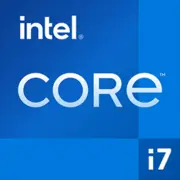Intel Core i7-9700F

Intel Core i7-9700F: A Comprehensive Review of the 2025 Processor
Relevance, Performance, and Build Tips
Key Features: Architecture and Performance
The Intel Core i7-9700F processor, released in 2019, remains a popular choice for budget PCs even in 2025. Its Coffee Lake architecture (14 nm) features 8 physical cores and 8 threads, ensuring high performance in single-threaded tasks. The base clock speed is 3.0 GHz, with Turbo Boost reaching up to 4.7 GHz.
Key Features:
- 12 MB L3 Cache — speeds up data processing in games and applications.
- TDP 65 W — low power consumption for a processor of this caliber.
- No integrated graphics (indicated by the "F" in its name) — requires a discrete graphics card.
Performance:
- Geekbench 6: 1542 (Single-Core), 6255 (Multi-Core).
- In games (e.g., Cyberpunk 2077 or Elden Ring) at Full HD with a graphics card like the NVIDIA RTX 3060, it shows stable performance at 60-90 FPS.
- For rendering in Blender or photo editing in Photoshop, it has enough power, but multi-threaded tasks (like video encoding) are slower compared to competitors with SMT/Hyper-Threading.
Compatible Motherboards: Sockets and Chipsets
The processor uses the LGA 1151 (v2) socket. Supported chipsets include:
- Z390 — overclocking, PCIe 3.0 x16, RAID support.
- H370/B365 — basic functionality without overclocking.
- H310 — budget option with limited ports.
Important! By 2025, new motherboards for LGA 1151 are rarely produced. Look for models on the secondary market or leftover stock:
- ASUS ROG Strix Z390-E ($120–150) — an optimal choice for overclocking.
- MSI B365M Pro-VDH ($70–90) — for budget builds.
Supported Memory: DDR4 and Configuration Tips
The i7-9700F works with DDR4 (up to 2666 MHz in basic chipsets, up to 4400 MHz in Z390 with overclocking). Recommendations:
- Capacity: 16 GB (2x8 GB) — the minimum for gaming and multimedia.
- Latency: CL16 or lower for better responsiveness.
- Example: Corsair Vengeance LPX 3200 MHz (CL16) kit — $55–65.
Limitation: DDR5 and PCIe 4.0/5.0 are not supported — this is a significant downside in 2025.
Power Supply: Power Calculation
With a TDP of 65 W, the processor has a modest impact on power consumption. However, considering the graphics card:
- For RTX 3060 (170 W), a PSU of 500–600 W (80+ Bronze/Gold) is sufficient.
- For RTX 4070 (200 W) — 650–750 W.
Tip: Choose models with modular cables (e.g., EVGA SuperNOVA 650 G6 — $90). Avoid cheap noname units to mitigate stability risks.
Pros and Cons of the i7-9700F in 2025
Advantages:
1. High single-threaded performance — relevant for games and applications not optimized for multi-threading.
2. Energy efficiency — suitable for compact builds.
3. Affordable price — $180–220 for a new processor (remaining stock).
Disadvantages:
1. 8 threads compared to 16 of competitors — lags in multitasking.
2. Outdated 14 nm process — higher heat output under load.
3. No support for PCIe 4.0 and DDR5 — limits upgrade potential.
Use Cases: Where Potential Shines Through
1. Gaming: Ideal for Full HD/1440p with a mid-range graphics card (RTX 3060 Ti, RX 7600 XT). In CS2 or Fortnite, it delivers 144+ FPS.
2. Office tasks and multimedia: Quick handling of browsers, office suites, and streaming video.
3. Moderate workloads: 3D modeling in AutoCAD, editing in Premiere Pro (for projects not requiring 8K).
Example: A build with the i7-9700F + RTX 4060 is an excellent choice for streaming games on Twitch.
Comparison with Competitors: AMD vs Intel
1. AMD Ryzen 5 7600 ($230):
- Pros: 6 cores/12 threads, support for DDR5 and PCIe 5.0.
- Cons: Higher price, requires a new motherboard (AM5).
2. Intel Core i5-13400F ($200):
- Pros: 10 cores (6P + 4E), support for DDR4/DDR5.
- Cons: TDP 65 W, but higher performance in multi-threaded tasks.
Conclusion: The i7-9700F lags behind new models but offers a price advantage for builds on older platforms.
Practical Build Tips
1. Cooling: The stock cooler is sufficient for standard operation, but opt for a tower cooler (e.g., DeepCool GAMMAXX 400 V2 — $25) for overclocking.
2. Motherboard: If you’re not planning to overclock, consider the B365 — it will save you $50.
3. Storage: Use an NVMe SSD (e.g., Kingston NV2 1 TB — $60) to speed up boot times.
Trap: Do not buy DDR4 with speeds above 2666 MHz for H370/B365 chipsets — they do not support memory overclocking.
Final Conclusion: Who Should Consider the i7-9700F?
This processor is worth considering if:
- Your budget is limited to $400–600 for the entire build.
- You need a gaming PC without requirements for 4K or AI tasks.
- You already have an LGA 1151 motherboard — this is a budget upgrade.
Alternative: If you're building a system from scratch in 2025, it’s better to choose the Ryzen 5 7600 or Core i5-13400F for future upgrade potential.
The Intel Core i7-9700F is a “workhorse” for those who appreciate a balance of price and performance. It may no longer be the king, but it remains a worthy contender in its niche.
Basic
CPU Specifications
Memory Specifications
Miscellaneous
Benchmarks
Compared to Other CPU
Share in social media
Or Link To Us
<a href="https://cputronic.com/en/cpu/intel-core-i7-9700f" target="_blank">Intel Core i7-9700F</a>